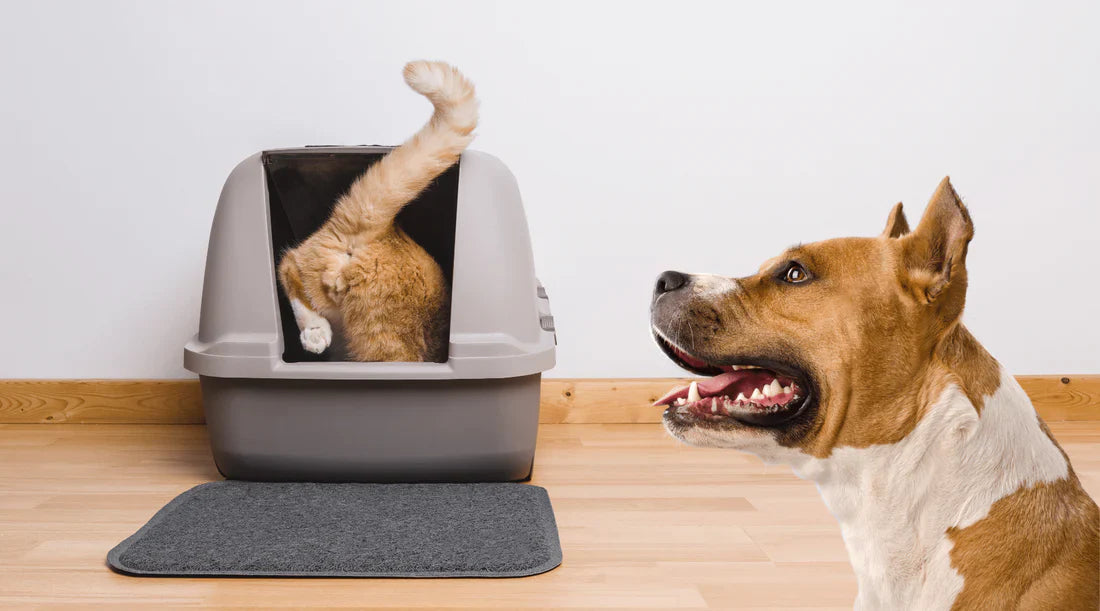
Why do my cat and dog keep eating cat litter?
If your cat or dog has developed a strange fascination with cat litter, you’re not alone. It’s one of the most common questions pet owners ask — and while it might seem harmless, this behaviour can sometimes signal deeper issues. Here’s what’s really going on and how to keep your pets safe.
Why kittens eat cat litter
Kittens under 12 weeks old are naturally curious and explore the world with their mouths. It’s part of their development, but it can lead them to taste or even eat litter.
Common reasons include:
-
Curiosity: The texture or smell can seem interesting to young kittens.
-
Nutritional deficiencies: Missing nutrients may lead them to experiment with non-food items.
-
Pica: A behavioural condition where animals eat things that aren’t food.
-
Anemia: Low iron levels can cause unusual cravings.
For kittens under 12 weeks, always use a non-clumping, plant-based litter. Clumping clay litters can cause digestive blockages if swallowed.
Why adult cats might eat cat litter
If your adult cat starts eating litter, it’s usually a sign of something more specific.
Possible causes include:
-
Nutritional imbalance or anemia: Cats may try to ingest minerals they’re lacking.
-
Pica or behavioural issues: Linked to stress, boredom, or underlying illness.
-
Environmental stress: Moving house, new pets, or changes to routine can trigger odd behaviours.
A quick vet check-up can rule out deficiencies or medical issues.
Why dogs eat cat litter
Dogs are notorious for raiding litter boxes. While it’s unpleasant, there’s often a simple explanation:
-
The smell of cat feces: Cat waste contains proteins and fats that appeal to dogs.
-
Curiosity: Dogs explore with their noses and mouths.
-
Boredom or anxiety: Dogs lacking stimulation may turn to scavenging behaviour.
-
Nutrient deficiency: Poor diet can trigger pica-like tendencies.
The best fix? Keep litter boxes out of reach with baby gates, enclosed boxes, or cat-only access areas.
The risks of eating clumping litter
Clumping cat litter, especially clay-based types containing sodium bentonite, can cause serious health issues when eaten.
Potential risks include:
-
Intestinal blockages: The litter expands when wet, creating obstructions.
-
Digestive upset: Even small amounts may cause vomiting, diarrhoea, or constipation.
-
Parasite exposure: Eating contaminated litter can spread bacteria and parasites, especially in dogs.
If your pet has eaten litter and shows signs of illness, contact your vet immediately.
Are plant-based litters safer?
Plant-based cat litters, like those made from pea husk, millet, or cassava, are generally safer if accidentally eaten in small amounts. They’re biodegradable, chemical-free, and gentle on the digestive system.
Cassava safety note: The cassava used in Eco 247’s litter is refined tapioca starch — not raw cassava. It’s the same ingredient found in tapioca pearls, gluten-free baking, and even some dry cat foods, making it safe in small accidental quantities.
Still, no litter should be deliberately eaten, so monitoring and prevention are key.
How to stop pets from eating cat litter
Step 1: Check for health issues
See your vet to rule out:
-
Nutritional deficiencies
-
Anemia
-
Pica or other behavioural concerns
Your vet can run tests or suggest dietary improvements if needed.
Step 2:
For cats |
For dogs |
|
Switch to a safe litter Keep the area clean Add enrichment
Redirect gently |
Block access Train and enrich
Check their diet |
When to call the vet
If your pet has eaten litter and shows symptoms such as:
-
Vomiting or diarrhoea
-
Lethargy
-
Swollen abdomen
-
Loss of appetite
Seek veterinary help right away. Early treatment can prevent serious complications like intestinal blockage.
Final thoughts
While eating cat litter isn’t unusual, it can be risky — especially with clumping clay products. Switching to plant-based litter reduces danger and supports a more sustainable home.
Keep an eye on your pets, maintain clean litter habits, and choose natural, non-toxic options for peace of mind. Small changes can make a big difference for your pets and the planet.
